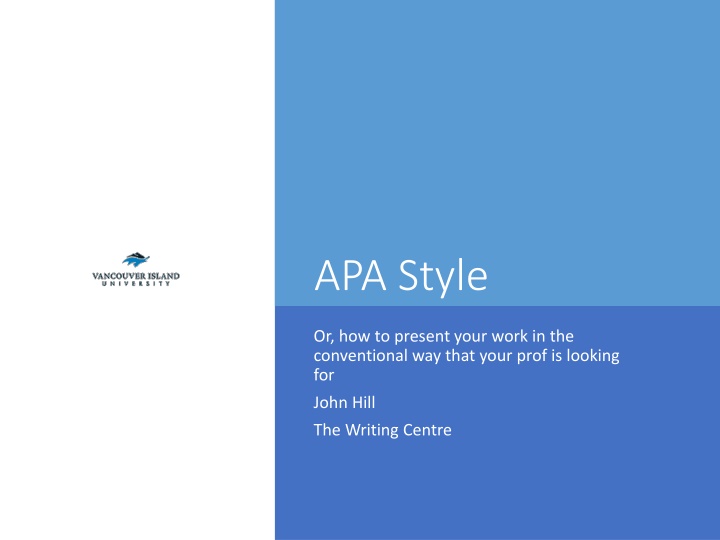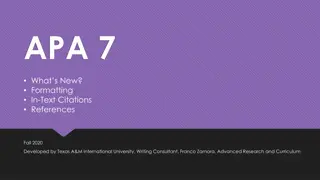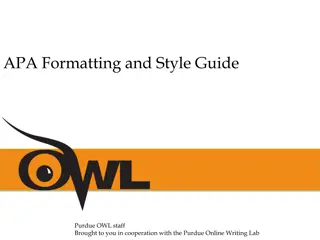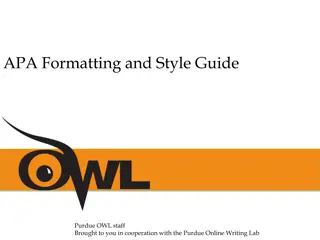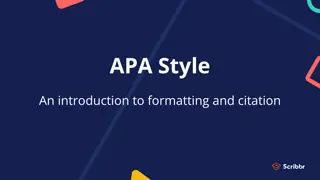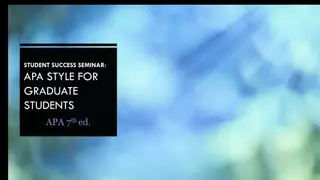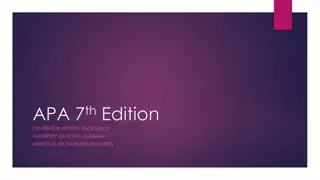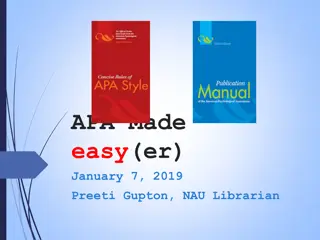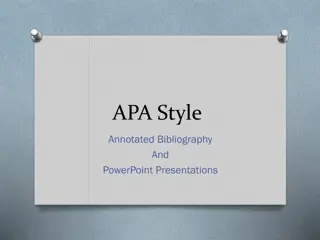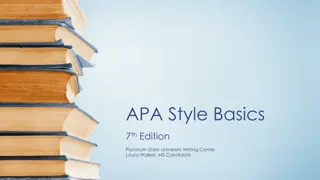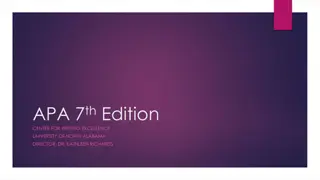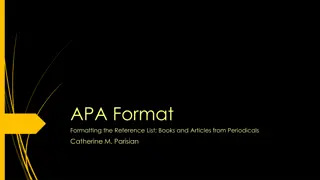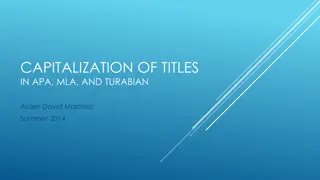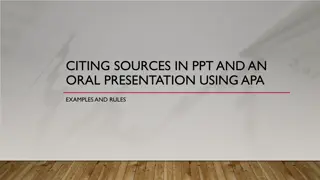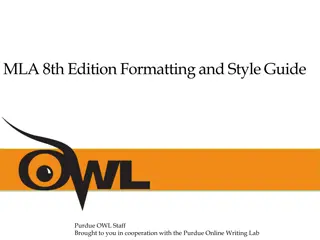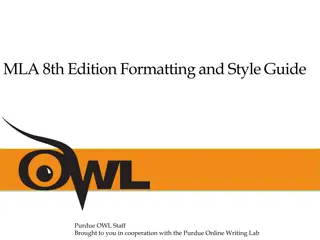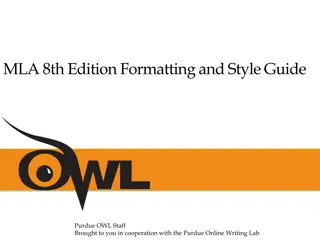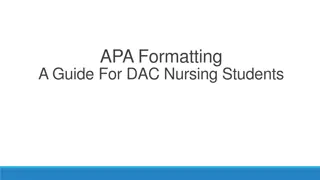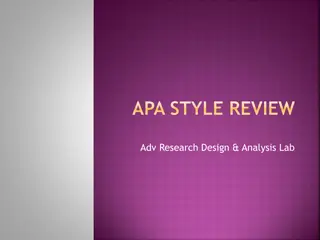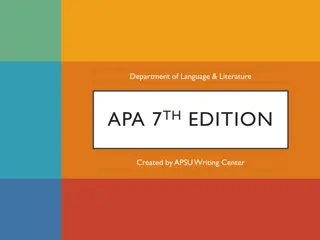Formatting Your Paper in APA Style for Academic Success
Learn the basics of APA formatting to impress your professor. Understand the required layout, headings, and parts of an APA paper to ensure your work meets the standard. Discover tips on creating a title page, using proper margins and font, and organizing your paper effectively.
Download Presentation

Please find below an Image/Link to download the presentation.
The content on the website is provided AS IS for your information and personal use only. It may not be sold, licensed, or shared on other websites without obtaining consent from the author.If you encounter any issues during the download, it is possible that the publisher has removed the file from their server.
You are allowed to download the files provided on this website for personal or commercial use, subject to the condition that they are used lawfully. All files are the property of their respective owners.
The content on the website is provided AS IS for your information and personal use only. It may not be sold, licensed, or shared on other websites without obtaining consent from the author.
E N D
Presentation Transcript
APA Style Or, how to present your work in the conventional way that your prof is looking for John Hill The Writing Centre
What is APA anyway? It stands for The American Psychological Association. They have established a widely used standard for the dissemination of knowledge in the sciences and social sciences. If your department uses this standard, so should you.
Basic layout of your paper Use standard white 8.5 by 11 paper Use I inch margins all around Use 12 point Times New Roman font Use double-spacing Indent paragraphs by 0.5, or one Tab -- i.e. one click of your Tab key (APA says your word processor s standard settings are acceptable ). Don t leave a gap between paragraphs. Tip: Use the APA report template in Word. Look at the pull-down menus at the top. Click on File . Then Click on New or New from templates depending on your version. Scroll down the templates to find it.
Levels of heading You can use sub-headings to organize your paper in APA according to the pattern below (OWL at Purdue, 2020). Level Format Centered, Boldface, Title Case Heading Text starts a new paragraph. 1 Flush left, Boldface, Title Case Heading Text starts a new paragraph. 2 Flush Left, Boldface Italic, Title Case Heading Text starts a new paragraph. 3 Indented, Boldface Title Case Heading Ending With a Period. Paragraph text continues on the same line as the same paragraph. 4 Indented, Boldface Italic, Title Case Heading Ending With a Period. Paragraph text continues on the same line as the same paragraph. 5
The parts of your APA paper: Title Page Title Page Header: APA 7thEdition no longer requires a running head for student papers. If your prof insists, it should be as follows: 1.Running head: At the top, in the header of the page, place a short version of the title of your paper (up to 50 characters, including punctuation and spaces) in UPPER CASE placed flush left. EG: THE USE OF SMARTPHONES IN THE K-8 CLASSROOM N.B. APA used to like the words Running head before the short title in the header-- just on the title page. They NO LONGER REQUIRE this even on professional papers. What should be in your header? The page number: flush right
Title page (cont) 1. In the upper half of the page The TITLE of your paper (duh!) bolded and centred, in title case (i.e. main words with capital first letter). Keep it succinct, but make it usefully descriptive of the contents: The Use of Smartphones in the K-8 Classroom to Enhance Independent Learning 2. White space 3. The author s name (that s you). First name, initials, last name: Jane A. Student 4. Departmental and Institutional affiliation: Department of English, Vancouver Island University. 5. Course title: ENGL 115: University Research and Writing 6. Prof s title and name: Dr. Miriam R. Cavendish-Hunter 7.Due Date: May 27, 2020
Abstract For professional research papers APA next requires a brief summary of the paper which they call an abstract. It s a single paragraph double-spaced of 150-250 words. Use the centred title, Abstract It s not required by APA for student essays. So only provide one if your prof has requested it.
Introduction Give the title again, centred and bolded BUT NOT underlined or italicised. Then provide your introduction, which does not need a title. The introduction describes the problem you are studying, why it is important, and your focus. It may simply conclude with a statement of what you conclude from your findings derived from your research your thesis, or you may add a brief guide to the structure of the paper. Thesis EXAMPLE: The introduction of smartphones to the K-8 classroom improves student engagement, and by empowering students enhances independent learning. The thesis forms a statement of your findings, the overall answer to your research question, the thing you wanted to know: can smartphones be used to improve outcomes in the K8 classroom? The guide for your readers might say something like. This issue will be explored through a consideration of existing studies, problems with conventional approaches, Phones as reference material, appropriate apps as tools ,and classroom management methods to deal with the problems phones produce.
Body of the essay You will then demonstrate how you reached this conclusion in a DISCUSSION of your findings through a series of related, relevant paragraphs, each covering an aspect of the study, as you announced in the intro: (1) The kinds of studies that have been done, (2) Problems students have with conventional approaches (3) Phones as reference material (4) Phone apps as tools (6) dealing with the problems phones introduce . NB If (as is often the case) there are multiple paragraphs on related sub- topics use subheadings (first level bold and centred; second level bold and flush left) You will provide EVIDENCE from your RESEARCH to support your assertions. And you will CITE that evidence in conventional APA style.
Citation? Whats that? Citation simply means the process of identifying the source of the information you give in your writing. It s a normal thing: Kathy says Joe has got into Harvard It answers the question: How do you know? Which is always a good question to ask.
Why do we cite our sources? Mainly: It gives authority to our work. It helps our fellow researchers who are reading our work. Also: It protects us against the charge of plagiarism that is, the serious charge of passing off others work as our own. Depending on your prof this can lead to failure of the paper, the course, and an interview with the Dean. Don t do it!
Do we have to cite everything? There is such a thing as Common Knowledge. If basic factual information is widely known and widely published without attribution (i.e. not cited) it is common knowledge, and does not have to be cited by you. For example the fact that The United States entered World War Two in 1941 would constitute such common knowledge. Not sure if it s common knowledge? Cite it!
How do we cite/refer to our sources in APA style? In essence, it s simple. When we use externally sourced material (words OR ideas) in our writing we provide the information necessary for our readers to go to that source themselves. We present that information in TWO PARTS: 1. The short IN-TEXT citation that accompanies the reference to the work in the body of your paper. This leads you to . 2. The full entry in your REFERENCES page at the end of your paper.
The In-text Citation APA uses an author/date system that is at each reference to the source you give the author s surname and the date of publication. There are TWO ways of doing this: 1. Use the author name in your sentence in what APA calls a NARRATIVE mode that introduces the cited material, and give the year of publication in parentheses with the name: Smith (2010) concluded that smartphones were already a feature of the classroom and that teachers have to learn to exploit them. 2. Put both author and date in parentheses after the sourced material. The presence of smartphones in the classroom means that teachers have to learn to exploit them (Smith, 2010).
Quoting and paraphrasing As you may have noticed, neither of my examples on the previous slide were QUOTATIONS (otherwise I would have put them in QUOTATION MARKS ) Rather I PARAPHRASED (put into my own words) what might have been substantial aspects of the article in question. BUT I STILL HAVE TO CITE THE SOURCE, as it does not thereby become my own work. It is still Smith that did the study and wrote up their results. The emphasis should be on using your own words to summarise/paraphrase your sources and explain/analyse the issues raised. When you quote, quote sparingly, and only as much of the section as is necessary. NB: when you paraphrase, try to avoid doing it at the sentence level: use your paraphrase to explain and summarise larger sections. This helps you avoid that rather pointless pastime of word substitution: changing the words of your source s sentence to make it your own.
Quoting If you use the author s actual words you must mark it as a quotation. Less than 40 words: place in quotation marks, and include the PAGE number in parentheses as follows: Smith (2010) suggested that smartphone use in the classroom runs the risk of reducing intellectual engagement with the material examined, by encouraging the student to see information as discrete packages of facts rather than complex cultural material that needs interpretation (p.21). NB include the page number in a paraphrase too if you are paraphrasing a specific part of the text in question that you could usefully direct your reader towards..
Longer quotes (>40 words) Over 40 word quotations: Set them out from your essay in a block by indenting the passage one tab. No need for quotation marks having done this: Chronic intractable wounds are dangerous and unpleasant for patients, and present an expensive problem for hospitals. The use of unconventional treatments such as the application of live maggots is becoming more accepted. van Veen (2008) noted the following: Maggot debridement therapy (MDT) is indicated for open wounds and ulcers that contain gangrenous or necrotic tissue with or without infection. Even though it is often used as a last resort treatment, our clinical experience suggests that it should be considered as initial treatment in selected cases. (p.1)
Multiple citations of a single source in a single paragraph There is such a thing in APA as over-citation. The system is supposed to clarify where your information came from, not to beat your reader over the head with it. To that end, if you use your source in a narrative citation near the start of your paragraph, you only have to do enough to keep your reader on track as to who is responsible for what in the rest of the paragraph. You do not for example have to give the date every time (However, if you use parenthetical citations you DO have to give the name and date each time). You have to start with a full citation if you use that source again in another paragraph though. What might this look like? According to Smith (2010), interplanetary travel will soon be as normal as apple pie on Sunday (p.23). Leaving aside the fact that apple pie on Sunday is not everyone s normality, Smith s observation that warp drives should present no technical difficulty is at the least contestible. Wang (2012) is equally certain that warp drives are fantasy, not science. But in the end, Human imagination always triumphs over human defeatism (Smith, 2010). Smith (2010) also argued that up is down (p.66). This suggests .
Citing secondary sources A secondary source refers to content first reported in another source. However, you should cite secondary sources sparingly (APA, 2020, p.258). If possible, you should find the primary source and use that. Let s say you read Smith (2010). Let s imagine Smith quotes Jones (2007). Let s say you like that quotation and want to use it, but you do not have access to Jones. You can cite it in the following way. Space is very big and crammed full of nothing, (Jones, 2007, as cited in Smith, 2010). And you will only put Smith in your References list, because you have not consulted Jones.
How do we present our sources in our How do we present our sources in our APA References page? APA References page? Typically you will be using online journals, physical books, and documents on organisations websites, so I will give you examples for each of these. Look up how to do more unusual sources (see final slide). But the general information is the same: WHO is responsible of the work (usually the author. If there is no author use the organisation as author if appropriate United Nations, say or a short version of the title if not. Whatever you use though, this should be what you list it under on your references page); WHEN was it written? Usually the year of publication: WHAT is it called? Usually the title of the piece of writing; other publication data such as for a book; And for almost any electronic source, either a Digital Object Identifier (DOI), or a URL if not. Arrange in alphabetical order by author s surname (or whatever is standing in for the author if there is no author given. Use a hanging indent Word will do it, use Word s Help to find out how. Use References bolded and centred for the title of this page.
Reference for an article from an online Reference for an article from an online journal journal Author surname, initials (date). Title of article. Title of Journal, (volume number) issue number, page-range. Link to Digital Object Identifier. Dikkers, S., & Squire, K. (2012). Amplifications of learning: use of mobile media devices among youth. Convergence: The International Journal of Research into New Media Technologies 18(4), 445-464. https://doi.org/10.1177/1354856511429646 If no DOI and you accessed it through an academic database, no need for a URL treat as print. But if it was not accessed through a database, give the URL. Note: no need any more for the language retrieved from.
Reference for a book Reference for a book Physical book, or ebook from academic database without a DOI Author surname, initials. (date). Title of Work. Publisher. Bergmann, J.,& Sams, A. (2012). Flip your classroom: reach every student in every class every day. ASCD. If the book has a DOI, add it at the end as a link. If the ebook came from a non-academic database, give its URL. In both cases stat with http:// or https://
Reference for an organisational Reference for an organisational website (No author) website (No author) Use the organisation in place of the author (if there is no author AND no obvious organisation responsible, use a short form of the title in the in-text citation and list under title in the references. But when you know so little, consider on what basis you are using it). If you haven t used the website name as the author, give it after the title. British Columbia Ministry of Education. (1996) Information technology k to 7. http://www.bced.gov.bc.ca/irp/resdocs/itk7.pdf Let s imagine it did have an author: John Smith. Smith, J. (1996) Information technology k to 7. British Columbia Ministry of Education. http://www.bced.gov.bc.ca/irp/resdocs/itk7.pdf
The References page References Bergmann, J., & Sams, A. (2012). Flip your classroom: reach every student in every class every day. ASCD. British Columbia Ministry of Education. (1996) Information technology k to 7. http://www.bced.gov.bc.ca/irp/resdocs/itk7.pdf Dikkers, S., & Squire, K. (2012). Amplifications of learning: use of mobile media devices among youth. Convergence: The International Journal of Research into New Media Technologies 18(4), 445-464. https://doi.org/10.1177/1354856511429646
Need more info? Info for this presentation came from The Publication Manual of the American Psychological Association, Seventh Edition. You could try The OWL at Purdue https://owl.purdue.edu/owl/research_and_citation/apa_style/apa_ style_introduction.html Or, why not ask APA themselves? https://apastyle.apa.org Try the style guidelines, and the APA editors blog is useful too.
